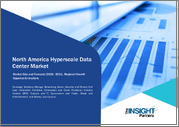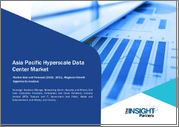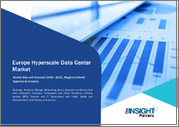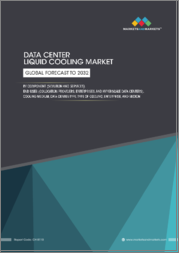
|
시장보고서
상품코드
1642651
메가 데이터센터 시장 : 컴포넌트, 최종사용자, 업계별, 지역별(2025-2033년)Mega Data Center Market by Component, End User, Industry Vertical (Banking, Financial Services and Insurance, Telecom and IT, Media and Entertainment, Government and Public, and Others), and Region 2025-2033 |
||||||
세계의 메가 데이터센터 시장 규모는 2024년에 268억 달러에 달했습니다. 향후 IMARC Group은 2033년에는 406억 달러에 달하며, 2025-2033년에 4.7%의 성장률(CAGR)을 보일 것으로 예측하고 있습니다. 시장을 촉진하는 것은 클라우드 서비스 수요의 증가, 빅데이터 분석의 성장, 인공지능(AI)과 기계학습(ML)의 채택 확대, 재생에너지 분야에 대한 투자의 증가, 엣지 컴퓨팅에 대한 주목의 증가 등입니다.
메가 데이터센터는 대규모 컴퓨팅 파워와 스토리지 용량을 제공하기 위해 설계된 대규모 시설입니다. 수백 대에서 수천 대의 서버, 스토리지 장비, 네트워크 장비를 저장하고 클라우드 컴퓨팅, 빅데이터, 사물인터넷(IoT) 등 다양한 용도과 서비스를 지원하기 위해 구축됩니다. 또한 생체인증을 통한 출입관리, 영상감시, 첨단 소방시스템 등 데이터센터 내에 저장된 데이터와 시스템을 보호하기 위한 첨단 보안 기능을 갖추고 있습니다. 또한 이러한 데이터센터는 소규모 데이터센터 시설에 비해 규모의 경제, 높은 에너지 효율성, 낮은 컴퓨팅 파워 및 스토리지 용량 단위당 비용 등 여러 가지 이점을 가지고 있습니다. 이러한 장점으로 인해 메가 데이터센터는 다양한 산업 분야에서 널리 활용되고 있습니다.
메가 데이터센터 시장 동향 :
시장의 주요 원동력은 클라우드 컴퓨팅에 대한 수요 증가로 인한 데이터센터 수요 증가입니다. 또한 코로케이션 서비스의 인기가 높아지는 것도 시장 성장의 주요 요인으로 작용하고 있습니다. 현재 기업은 IT 인프라를 아웃소싱하고 있으며, 코로케이션 서비스에 적합하고 규모의 경제, 보안, 고가용성을 제공하는 메가 데이터센터의 도입이 가속화되고 있습니다. 이와 더불어 기업은 비즈니스 연속성을 보장하기 위해 재해복구 솔루션에 대한 투자를 늘리고 있습니다. 메가 데이터센터는 이중화 및 페일오버 기능을 갖춘 강력한 재해복구 인프라를 제공하므로 고가용성을 필요로 하는 기업에게 이상적인 솔루션이 되고 있습니다. 이는 정부의 적극적인 노력과 규제 시행과 맞물려 시장 성장에 긍정적인 영향을 미치고 있습니다. 현재 각국 정부는 디지털 혁신 활동을 지원하기 위해 데이터센터 인프라 업그레이드에 투자하고 있습니다. 또한 데이터 프라이버시 및 보안에 대한 규제로 인해 기업은 최신 규정을 준수하는 데이터센터 인프라에 투자하고 있습니다. 또한 빅데이터와 사물인터넷(IoT)으로 인해 생성되는 데이터가 폭발적으로 증가함에 따라 더 많은 스토리지와 처리 능력에 대한 요구가 급증하고 있으며, 방대한 양의 데이터를 처리하고 저장할 수 있는 메가 데이터센터의 도입이 가속화되고 있습니다. 이러한 요인들로 인해 향후 수년간 이 시장은 긍정적인 성장을 보일 것으로 예상됩니다.
목차
제1장 서문
제2장 조사 범위와 조사 방법
- 조사의 목적
- 이해관계자
- 데이터 소스
- 1차 정보
- 2차 정보
- 시장 추정
- 보텀업 어프로치
- 톱다운 어프로치
- 조사 방법
제3장 개요
제4장 서론
- 개요
- 주요 업계 동향
제5장 세계의 메가 데이터센터 시장
- 시장 개요
- 시장 실적
- COVID-19의 영향
- 시장 예측
제6장 시장 내역 : 컴포넌트별
- 솔루션
- 시장 동향
- 주요 부문
- IT 인프라 솔루션
- 지원 인프라 솔루션
- 전원 솔루션
- 냉각 솔루션
- 보안 솔루션
- 관리 소프트웨어
- 시장 예측
- 서비스
- 시장 동향
- 주요 부문
- 시스템 통합
- 감시 서비스
- 전문 서비스
- 시장 예측
제7장 시장 내역 : 최종사용자별
- 클라우드 프로바이더
- 시장 동향
- 시장 예측
- 코로케이션 프로바이더
- 시장 동향
- 시장 예측
- 기업
- 시장 동향
- 시장 예측
제8장 시장 내역 : 업계별
- 은행, 금융 서비스, 보험(BFSI)
- 시장 동향
- 시장 예측
- 통신·IT
- 시장 동향
- 시장 예측
- 미디어와 엔터테인먼트
- 시장 동향
- 시장 예측
- 정부와 공공
- 시장 동향
- 시장 예측
- 기타
- 시장 동향
- 시장 예측
제9장 시장 내역 : 지역별
- 북미
- 미국
- 캐나다
- 아시아태평양
- 중국
- 일본
- 인도
- 한국
- 호주
- 인도네시아
- 기타
- 유럽
- 독일
- 프랑스
- 영국
- 이탈리아
- 스페인
- 러시아
- 기타
- 라틴아메리카
- 브라질
- 멕시코
- 기타
- 중동 및 아프리카
- 시장 동향
- 시장 내역 : 국가별
- 시장 예측
제10장 촉진요인·억제요인·기회
- 개요
- 촉진요인
- 억제요인
- 기회
제11장 밸류체인 분석
제12장 Porter's Five Forces 분석
- 개요
- 바이어의 교섭력
- 공급 기업의 교섭력
- 경쟁의 정도
- 신규 진출업체의 위협
- 대체품의 위협
제13장 가격 분석
제14장 경쟁 구도
- 시장 구조
- 주요 기업
- 주요 기업의 개요
- Cisco Systems Inc.
- Dell Technologies Inc.
- Fujitsu Limited
- Hewlett Packard Enterprise Company
- Intel Corporation
- International Business Machines Corporation
- Juniper Networks Inc.
- Schneider Electric SE
The global mega data center market size reached USD 26.8 Billion in 2024. Looking forward, IMARC Group expects the market to reach USD 40.6 Billion by 2033, exhibiting a growth rate (CAGR) of 4.7% during 2025-2033. The market is driven by the increasing demand for cloud services, growth of big data analytics, rising adoption of artificial intelligence (AI) and machine learning (ML), heightened investment in the renewable energy sector, and the burgeoning focus on edge computing.
A mega data center is a large-scale facility designed to provide massive computing power and storage capacity. It is built to store hundreds or thousands of servers, storage devices, and networking equipment and support a variety of applications and services, such as cloud computing, Big Data, and the Internet of Things (IoT). It is also equipped with advanced security features to protect the data and systems stored within them, such as biometric access controls, video surveillance, and advanced fire suppression systems. In addition, these data centers offer several advantages over smaller data center facilities, such as better economies of scale, higher energy efficiency, and lower costs per unit of computing power and storage capacity. Owing to these benefits, mega data centers are widely utilized across various industrial verticals.
Mega Data Center Market Trends:
The market is primarily driven by the increasing demand for cloud computing, which is escalating the demand for data centers. In addition, the growing popularity of colocation services represents another major growth-inducing factor. Nowadays, companies are outsourcing their IT infrastructure, which is accelerating the adoption of mega data centers as they are ideal for colocation services and provide economies of scale, security, and high availability. Besides this, companies are increasingly investing in disaster recovery solutions to ensure business continuity. Mega data centers provide a robust disaster recovery infrastructure with redundancy and failover capabilities, making them an ideal solution for companies that require high levels of availability. This, coupled with the implementation of favorable government initiatives and regulations, is positively influencing the market growth. At present, governments of numerous countries are investing in upgrading data center infrastructure to support their digital transformation activities. Additionally, regulations around data privacy and security are driving companies to invest in data center infrastructure that is compliant with the latest regulations. Moreover, with the explosion of data generated by Big Data and the Internet of Things (IoT), there is a surging need for more storage and processing capabilities, which is accelerating the adoption of mega data centers that are capable of processing and storing vast amounts of data. On account of these factors, the market is expected to witness positive growth in the coming years.
Mega Data Center Market Segmentation:
Component Insights:
- Solutions
- IT Infrastructure Solutions
- Support Infrastructure Solutions
- Power Solutions
- Cooling Solutions
- Security Solutions
- Management Software
- Services
- System Integration
- Monitoring Services
- Professional Services
End User Insights:
- Cloud Providers
- Collocation Providers
- Enterprises
Industry Vertical Insights:
- Banking, Financial Services and Insurance (BFSI)
- Telecom and IT
- Media and Entertainment
- Government and Public
- Others
Regional Insights:
- North America
- United States
- Canada
- Europe
- Germany
- France
- United Kingdom
- Italy
- Spain
- Russia
- Others
- Asia Pacific
- China
- Japan
- India
- South Korea
- Australia
- Indonesia
- Others
- Latin America
- Brazil
- Mexico
- Others
- Middle East and Africa
- The report has also provided a comprehensive analysis of all the major regional markets, which include North America (the United States and Canada); Europe (Germany, France, the United Kingdom, Italy, Spain, Russia, and others); Asia Pacific (China, Japan, India, South Korea, Australia, Indonesia, and others); Latin America (Brazil, Mexico, and others); and the Middle East and Africa. According to the report, North America was the largest market for mega data center. Some of the factors driving the North America mega data center market included the rising adoption of cloud computing, the growing demand for data storage and processing, and the increasing investments in cybersecurity.
Competitive Landscape:
- The report has also provided a comprehensive analysis of the competitive landscape in the global mega data center market. Detailed profiles of all major companies have also been provided. Some of the companies covered include Cisco Systems Inc., Dell Technologies Inc., Fujitsu Limited, Hewlett Packard Enterprise Company, Intel Corporation, International Business Machines Corporation, Juniper Networks Inc., Schneider Electric SE, etc. Kindly note that this only represents a partial list of companies, and the complete list has been provided in the report.
Key Questions Answered in This Report
- 1. How big is the global mega data center market?
- 2. What is the expected growth rate of the global mega data center market during 2025-2033?
- 3. What are the key factors driving the global mega data center market?
- 4. What has been the impact of COVID-19 on the global mega data center market?
- 5. What is the breakup of the global mega data center market based on the end user?
- 6. What is the breakup of the global mega data center market based on the industry vertical?
- 7. What are the key regions in the global mega data center market?
- 8. Who are the key players/companies in the global mega data center market??
Table of Contents
1 Preface
2 Scope and Methodology
- 2.1 Objectives of the Study
- 2.2 Stakeholders
- 2.3 Data Sources
- 2.3.1 Primary Sources
- 2.3.2 Secondary Sources
- 2.4 Market Estimation
- 2.4.1 Bottom-Up Approach
- 2.4.2 Top-Down Approach
- 2.5 Forecasting Methodology
3 Executive Summary
4 Introduction
- 4.1 Overview
- 4.2 Key Industry Trends
5 Global Mega Data Center Market
- 5.1 Market Overview
- 5.2 Market Performance
- 5.3 Impact of COVID-19
- 5.4 Market Forecast
6 Market Breakup by Component
- 6.1 Solutions
- 6.1.1 Market Trends
- 6.1.2 Key Segments
- 6.1.2.1 IT Infrastructure Solutions
- 6.1.2.2 Support Infrastructure Solutions
- 6.1.2.3 Power Solutions
- 6.1.2.4 Cooling Solutions
- 6.1.2.5 Security Solutions
- 6.1.2.6 Management Software
- 6.1.3 Market Forecast
- 6.2 Services
- 6.2.1 Market Trends
- 6.2.2 Key Segments
- 6.2.2.1 System Integration
- 6.2.2.2 Monitoring Services
- 6.2.2.3 Professional Services
- 6.2.3 Market Forecast
7 Market Breakup by End User
- 7.1 Cloud Providers
- 7.1.1 Market Trends
- 7.1.2 Market Forecast
- 7.2 Collocation Providers
- 7.2.1 Market Trends
- 7.2.2 Market Forecast
- 7.3 Enterprises
- 7.3.1 Market Trends
- 7.3.2 Market Forecast
8 Market Breakup by Industry Vertical
- 8.1 Banking, Financial Services and Insurance (BFSI)
- 8.1.1 Market Trends
- 8.1.2 Market Forecast
- 8.2 Telecom and IT
- 8.2.1 Market Trends
- 8.2.2 Market Forecast
- 8.3 Media and Entertainment
- 8.3.1 Market Trends
- 8.3.2 Market Forecast
- 8.4 Government and Public
- 8.4.1 Market Trends
- 8.4.2 Market Forecast
- 8.5 Others
- 8.5.1 Market Trends
- 8.5.2 Market Forecast
9 Market Breakup by Region
- 9.1 North America
- 9.1.1 United States
- 9.1.1.1 Market Trends
- 9.1.1.2 Market Forecast
- 9.1.2 Canada
- 9.1.2.1 Market Trends
- 9.1.2.2 Market Forecast
- 9.1.1 United States
- 9.2 Asia-Pacific
- 9.2.1 China
- 9.2.1.1 Market Trends
- 9.2.1.2 Market Forecast
- 9.2.2 Japan
- 9.2.2.1 Market Trends
- 9.2.2.2 Market Forecast
- 9.2.3 India
- 9.2.3.1 Market Trends
- 9.2.3.2 Market Forecast
- 9.2.4 South Korea
- 9.2.4.1 Market Trends
- 9.2.4.2 Market Forecast
- 9.2.5 Australia
- 9.2.5.1 Market Trends
- 9.2.5.2 Market Forecast
- 9.2.6 Indonesia
- 9.2.6.1 Market Trends
- 9.2.6.2 Market Forecast
- 9.2.7 Others
- 9.2.7.1 Market Trends
- 9.2.7.2 Market Forecast
- 9.2.1 China
- 9.3 Europe
- 9.3.1 Germany
- 9.3.1.1 Market Trends
- 9.3.1.2 Market Forecast
- 9.3.2 France
- 9.3.2.1 Market Trends
- 9.3.2.2 Market Forecast
- 9.3.3 United Kingdom
- 9.3.3.1 Market Trends
- 9.3.3.2 Market Forecast
- 9.3.4 Italy
- 9.3.4.1 Market Trends
- 9.3.4.2 Market Forecast
- 9.3.5 Spain
- 9.3.5.1 Market Trends
- 9.3.5.2 Market Forecast
- 9.3.6 Russia
- 9.3.6.1 Market Trends
- 9.3.6.2 Market Forecast
- 9.3.7 Others
- 9.3.7.1 Market Trends
- 9.3.7.2 Market Forecast
- 9.3.1 Germany
- 9.4 Latin America
- 9.4.1 Brazil
- 9.4.1.1 Market Trends
- 9.4.1.2 Market Forecast
- 9.4.2 Mexico
- 9.4.2.1 Market Trends
- 9.4.2.2 Market Forecast
- 9.4.3 Others
- 9.4.3.1 Market Trends
- 9.4.3.2 Market Forecast
- 9.4.1 Brazil
- 9.5 Middle East and Africa
- 9.5.1 Market Trends
- 9.5.2 Market Breakup by Country
- 9.5.3 Market Forecast
10 Drivers, Restraints, and Opportunities
- 10.1 Overview
- 10.2 Drivers
- 10.3 Restraints
- 10.4 Opportunities
11 Value Chain Analysis
12 Porters Five Forces Analysis
- 12.1 Overview
- 12.2 Bargaining Power of Buyers
- 12.3 Bargaining Power of Suppliers
- 12.4 Degree of Competition
- 12.5 Threat of New Entrants
- 12.6 Threat of Substitutes
13 Price Analysis
14 Competitive Landscape
- 14.1 Market Structure
- 14.2 Key Players
- 14.3 Profiles of Key Players
- 14.3.1 Cisco Systems Inc.
- 14.3.1.1 Company Overview
- 14.3.1.2 Product Portfolio
- 14.3.1.3 Financials
- 14.3.1.4 SWOT Analysis
- 14.3.2 Dell Technologies Inc.
- 14.3.2.1 Company Overview
- 14.3.2.2 Product Portfolio
- 14.3.2.3 Financials
- 14.3.2.4 SWOT Analysis
- 14.3.3 Fujitsu Limited
- 14.3.3.1 Company Overview
- 14.3.3.2 Product Portfolio
- 14.3.3.3 Financials
- 14.3.3.4 SWOT Analysis
- 14.3.4 Hewlett Packard Enterprise Company
- 14.3.4.1 Company Overview
- 14.3.4.2 Product Portfolio
- 14.3.4.3 Financials
- 14.3.4.4 SWOT Analysis
- 14.3.5 Intel Corporation
- 14.3.5.1 Company Overview
- 14.3.5.2 Product Portfolio
- 14.3.5.3 Financials
- 14.3.5.4 SWOT Analysis
- 14.3.6 International Business Machines Corporation
- 14.3.6.1 Company Overview
- 14.3.6.2 Product Portfolio
- 14.3.6.3 Financials
- 14.3.6.4 SWOT Analysis
- 14.3.7 Juniper Networks Inc.
- 14.3.7.1 Company Overview
- 14.3.7.2 Product Portfolio
- 14.3.7.3 Financials
- 14.3.7.4 SWOT Analysis
- 14.3.8 Schneider Electric SE
- 14.3.8.1 Company Overview
- 14.3.8.2 Product Portfolio
- 14.3.8.3 Financials
- 14.3.8.4 SWOT Analysis
- 14.3.1 Cisco Systems Inc.
Kindly note that this only represents a partial list of companies, and the complete list has been provided in the report.



















